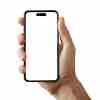True Tone: silent protection for your eyes
Your screen adapts. Constantly. Without you even realizing it. That yellow glow at night, the bright white during the day – True Tone handles it all automatically. Sounds convenient, but many users actually turn it off. Too yellow, they say. Colors are no longer accurate. Photographers and designers hate it.
Yet they completely miss the point. True Tone isn't about perfect colors at all. It's about your eyes no longer burning after eight hours of work . About headaches that stay away. About a screen that feels like paper, not a light box. Just like your AirPods automatically switch between devices , True Tone adapts seamlessly to your environment. And those accessories for better ergonomics ? They become unnecessary when your screen automatically thinks along with your eyes.
Useful links
- Refurbished iPhone with True Tone
- Refurbished iPad with True Tone
- Refurbished MacBook with True Tone
The real story behind True Tone
True Tone is perhaps the most underrated feature on your Apple device. Not because it's revolutionary, but precisely because it works so unobtrusively. It continuously adjusts the color temperature of your screen based on the ambient light. Cooler whites during the day, warmer yellows in the evening. Just like white paper looks different under different lighting conditions.
Many users turn the feature off because they think it'll "rui" their screen. Photographers complain about inaccurate colors. Designers fear for their color palettes. But they're missing the point: True Tone isn't meant for color-critical work. It's meant for the other 95% of your screen time.
Why your eyes thank you
Your eyes adapt to different lighting conditions throughout the day, from the soft morning light to the bright fluorescent office light. True Tone allows your screen to follow this natural adjustment. Without this technology, you'd be looking at a constant light source that doesn't take your surroundings into account.
You'll especially notice the difference after a long workday. Those burning eyes? That headache slowly creeping up? Often, it's the contrast between your screen and the environment. True Tone significantly reduces this contrast. The screen feels more like a natural part of your work environment, not a bright light box.
The science behind it
The sensors in your device measure not only the brightness but also the color temperature of the ambient light. This happens thousands of times per second. The processor then calculates the optimal adjustment for your screen. The result: a display that behaves just like paper would under varying lighting conditions.
Practical use for various situations
For the average user, True Tone is a blessing. Reading emails, browsing, watching videos—everything feels more natural. But there are times when you're better off turning it off:
- Photo Editing: Temporarily disable True Tone for accurate color reproduction
- Graphic Design: Turn it off when color accuracy is crucial
- Online Shopping: Consider Opting Out When Viewing Product Photos
For everything else, just leave True Tone on. After a week, you won't even notice it's active. Until you turn it off and are suddenly confronted with a screen that feels far too blue or bright.
Which devices support it?
Apple introduced True Tone on the iPad Pro in 2016. Since then, the technology has been rolled out to virtually all new devices. The iPhone has supported it since the iPhone 8, the iPad since the third-generation Air, and MacBooks have had the feature since 2018.
Interesting detail: older refurbished models without True Tone are often considerably cheaper. This might be a consideration for users who primarily do basic work. But for those who spend hours in front of a screen every day, investing in a model with True Tone is worth the extra money.
Night Shift versus True Tone
These two features are often confused, but they serve different purposes. Night Shift filters blue light in the evening to protect your sleep pattern. True Tone adjusts the overall color balance based on ambient light, all day long. You can use both features simultaneously—they even enhance each other.
Tips for optimal use
Start with the default settings. Apple has carefully tuned these for most situations. Give yourself a week to adjust before making a decision. The screen may appear too yellow for the first few days, especially in the evenings. This feeling disappears quickly.
If you're still having trouble adjusting the brightness, try lowering your screen brightness slightly. True Tone works best when your screen isn't at maximum brightness. Automatic brightness control can also help for an even more natural experience.
Do you work a lot with external monitors? Unfortunately, only the Studio Display supports True Tone when connected to a Mac. This can take some getting used to when switching between your MacBook screen and an external monitor without this technology.
The future of screen customization
True Tone is just the beginning. Apple is experimenting with even more advanced adjustments. Think of displays that adjust not only color temperature, but also contrast and saturation based on content and surroundings. The technology is becoming increasingly subtle and effective.
For now, True Tone remains one of those features you only appreciate when you have to live without it. It's not a spectacular innovation that impresses your friends. It's a quiet improvement that makes your daily experience more enjoyable. And isn't that exactly what good technology should do?
The power of invisible technology
True Tone isn't a flashy feature you show off, but rather a quiet force that makes your screen time more enjoyable. It protects your eyes without you having to think about it, just like a good office chair supports your back without you even realizing it. For color-critical work, you can turn it off, and for everything else, you can simply leave it on.
Whether you choose a refurbished iPhone , iPad , or MacBook with True Tone, your eyes will thank you after long workdays. Sometimes the best technology is the one you don't notice.

